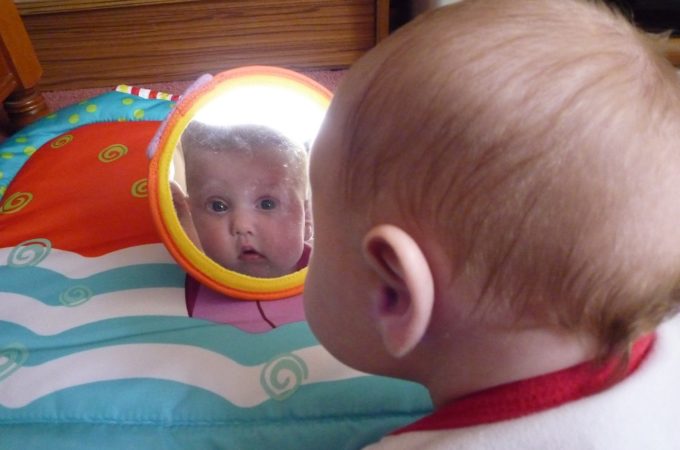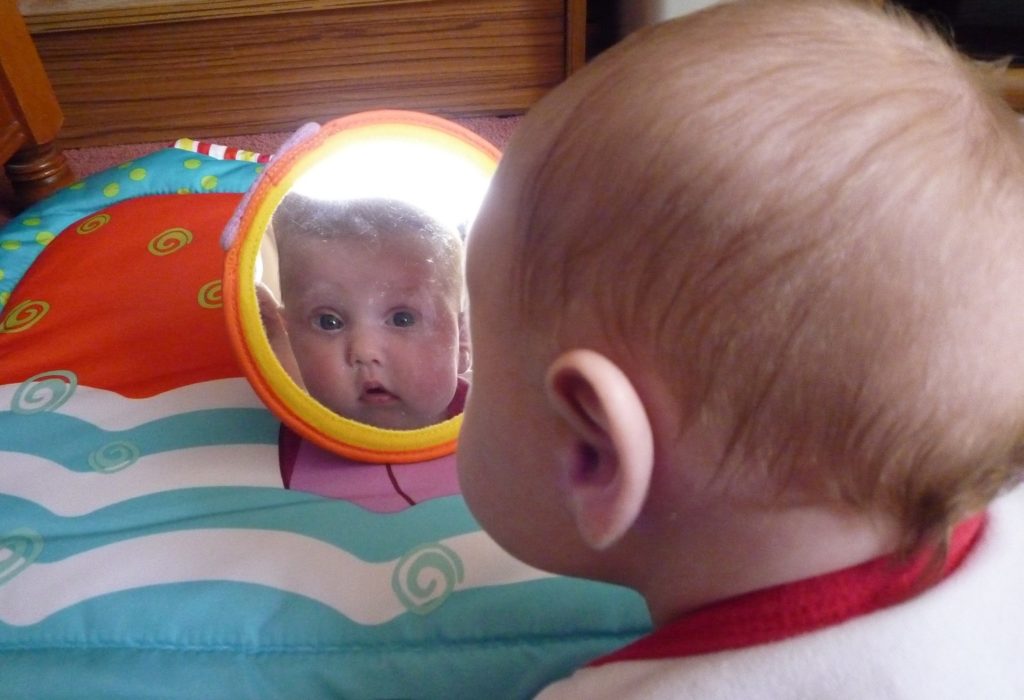Does your baby love looking at himself in the mirror?
As early as 3 months old, babies show a strong preference for looking at people’s faces, and focus on them for longer periods of time. Why? Let’s face it – faces are pretty interesting! Our expressions change frequently, and as we’re speaking or making sounds our mouths move in different directions.
Our faces also convey a lot of important social information. Research shows that babies and young children often look to parents’ facial expressions and emotional reactions to understand a new situation. They also look at the facial reactions of their parents when they are trying to determine how to act in new situations. For example when your baby first notices a puppy in the room she may look at the dog and then look back at her mother’s face and her facial expression. If mom has a fearful look, the baby is less likely to approach the dog than if the mother has a look of encouragement.
This seemingly simple act of looking at people’s faces is actually far from simple when you consider everything your baby is learning.
Playing in the mirror is a great activity for giving your child more opportunity to look at faces. Here are some examples of mirror activities you might already be doing with your baby:
- Sitting in front of a mirror and making silly faces, sounds or actions back and forth at one another.
- This is an example of a simple activity that allows your child to develop social emotional skills as he watches and tries to understand the variety of facial expressions you make.
- You will be practicing communication skills such as turn-taking as you go back and forth making faces and sounds at one another. You are also providing opportunity for your child to watch your mouth as you make different sounds.
- Waiting and allowing your child to imitate the different facial expressions, sounds or actions you model, supports physical development.
- Pointing to different body parts or objects in view
- While doing this you are modeling a very important foundational skill for language development – Pointing. Did you know that studies show your child’s use of pointing and gestures at 14 months old is the best predictor of later vocabulary size? So keep pointing and showing your child how it’s done! (Check out our posts here and here on the importance of pointing.)
- Practicing pointing is also great for physical development and getting those fingers moving independently which is necessary for more complex fine motor hand movements such as picking up small items, playing the piano, and having thumb wars with friends.
It’s pretty cool to sit back and think about how you’ve been working on so many different aspects of development during these simple activities – isn’t it?
Here are some other mirror activities you may want to add to your repertoire.
- Blowing on the mirror to make a fog then swiping your finger through the fog.
- You can help to expand your child’s attention by building anticipation as you are about to fog the mirror (e.g. One, two, three….{fog up the mirror}). Then you can support physical development by having your baby help to wipe away the fog using his whole hand and gradually supporting him to use individual fingers, supporting the development of fine motor skills.
- Playing the ‘wave game’
- You can play a variation of peek-a-boo in the mirror, moving in and out of view and modeling the gesture of waving “hello” as you re-appear and waving “bye” before you disappear. Waving is one of the earliest gestures children use and you’ll recall we shared earlier that gesturing and pointing have been found to be the best predictors of later vocabulary size.
Watch for our post next week when we discuss how playing with lipstick can help us answer the question – When do babies start to recognize their own reflection?
In the meantime let us know what mirror games you enjoy playing with your baby.
—
Amanda



